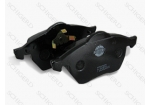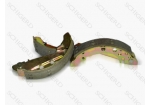
For clients / Direction on brake blocks installation
The direction is general recommendation on brake blocks replacement.
Company SCHIGERD® advises to use the instruction provided by car producer while brakes handling.
To achieve optimal effectiveness while braking we recommend changing brake blocks together with brake disks when it is necessary.
Accident prevention:
Make sure that the car is situated on the flat surface. If you serve the front brakes use the manual brakes and if the car is with back driving put the transmission on. When the back brakes are served put the first transmission on the front driving car. Also always block the wheels which do not go up.
Preparing to the work:
Before starting the work make sure that you have the following instruments: lifting jack, struts, spanner, pliers, screwdriver, wire brush and cleaning fabric. You also need braking lubricant and new braking liquid.
Attention: It is necessary to change brake blocks at both wheel of the axle to avoid misbalance while braking.
Removal of the wheel:
Loose the bolts of the wheels till their rising above the ground. Lift the car using lifting jack and fasten it with supports and take the wheel off.
Additional recommendations:
Take off the filler cap from the main braking drum and wrap it with fabric or other absorbing material to protect the paint coat.
Attention:
Brakes blocks straps SCHIGERD® are produced without using asbestos but never the less replaceable worn straps may contain asbestos. Care for dust removal using vacuum cleaner or wet fabric.
Never use air under pressure for dust removal.
Removal of the worn straps:
If the straps are provided with adjusting disk held by bolts and springs, attentively remember their arrangement for following installation. If you plan to use them again, make sure that they are cleaned. Some braking blocks are provided with wear indicators which is necessary to disconnect previously remembering their arrangement. Turn off bolts holding the brakes blocks and remove the blocks (if the difficulties while removal arise use the pliers) remember the arrangement of the each block on the saddle.
Keep the old braking blocks to make the installation of the new ones easier.
Examination of the disks:
Every time when serving the braking blocks examine the braking dist from both sides for the presence of scratches at the working surface. Deep scratches cause increased wear of the braking straps. If the braking disk was damaged as the result of the contact with steel base of the braking blocks in consequence of their untimely change, the disks are to be removed. If the diskes are worn more than their minimal width, they are to be removed (minimal width is usually indicated at the flanck of the disk).
Remember: It is necessary to change braking disks at both wheels of the axle.
Corrosion of disk may cause rust appearance on the internal and external sides. It may be removed with file or flat screwdriver fixed at the support while disk rotating. Polish with emery paper and check the disk wear. If the wear exceeds the maximum allowed by the producer (as a rule wear is not to exceed 0.1 mm), it is necessary to remove the disk.
Cleaning:
Clean the breaking support from dirt with wet fabric or if dissolvent is necessary, ethyl alcohol is to be used. Examine rubber dusters covering braking cylinders pistons and replace them if they are damaged. Check the braking cylinders pistons for corrosion and replace them together with compactors if it is necessary. If any of braking cylinders pistons seize, replace them. Check for tracks of liquid streak under compactor or flexible hoses. It is very important to clean the accessible surface of the piston and cavities of the braking blocks with braking liquid or ethyl alcohol.
Compressing of breaking cylinder:
With smooth and even pressing squash the pistons into the cylinders with suitable arm (special instruments may be obtained for the procedure). The rest of the braking liquid may be removed through the leakage screw of support pressing. Clip the leakage screw of pressing when the liquid is still running. If it is possible turn the piston till the total combining is obtained. Different acts are often necessary to squash the back piston of the cylinder, that is why it is necessary to use technical service manual.
Installation of new braking blocks:
Grease the back side of new brakes with braking lubricant paying attention to it not get onto working side of the braking blocks. Bush braking blocks into the support in the position they were. Mount bolts and springs in the back consistency of removal and, if the wear indicators are, connect them to electric wire.
Gap between new braking blocks and disks is removed by pressing the braking pedal until it is bumping. Make sure that the tank for breaking liquid is full before and after the procedure. Make sure that disk rotates easily between braking blocks not touching them. Install the wheel and clip the bolts according to the manual to your car.
Brakes checking:
Brakes checking is to be carried out on an flat and even road by great braking. A car is to brake without hitches, additional efforts and exceeded pedaling. If the pedaling is exceeded, most probably air got into the braking system. It may be corrected by scouring of liquid for air removal. Braking effectiveness improves after braking blocks work.
Attention: After checking up avoid intensive braking during first 250-300 km, especially if new braking disks were installed. Not fulfillment of these recommendations may seriously effect the braking effectiveness.
Daily care:
Disk brakes are self-adjusting that is why they do not need often service, but it is necessary to watch the wear every 8000 km. If braking blocks are washed at minimal width 2 mm, it is necessary to replace them. When checking braking blocks up, it is desirable to check braking cylinder and hoses for the purpose of liquid leaking and other damage.



















